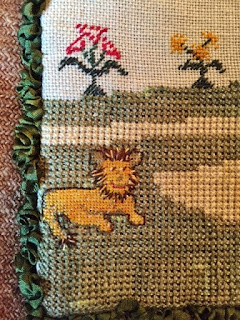A note from Ann - A few of my wallets were stitched without a pattern, that I adapted from photos and information.
I use them for my personal use only and don't sell, profit or share any of my
drawings. I just want to be sure all understand that some are my interpretation and reproduction of originals I have seen photos of,
and I do them just for the joy of stitching them.
************************
#1 This is my adaptation of a 1730-1780 Winterthur Pocketbook bequest of Henry Francis duPont. I used the pictures/information they show online in their Collections section and transferred it to 28 ct linen. I hand stitched the entire wallet with tent stitch using Textile Reproductions vegetable dyed wool thread, vegetable dyed linen lining and tape binding.
Tent stitch is a small diagonal stitch that crosses over the intersection of one horizontal (weft) and one vertical (warp) thread of linen or canvas forming a slanted stitch at a 45 degree angle. This is a look at examples of the tent stitch ...
https://en.wikipedia.org/wiki/Tent_stitch
************************
#2
This is an unfinished Bargello/flamestitch fragment that I adapted using my
stash for completion so the colors aren't too exact. Wool threads, mostly
Paternayan, on 28 ct linen, with a leftover piece of vegetable dyed linen for
the lining and a reproduction clasp for closure was used. A picture of the
original piece (Unfinished fragment) is shown below.
Bargello is a form of needlework utilizing vertical (straight up and down) stitches that move in a series of "steps" up, across and down the fabric to create a repetitive geometric design. My favorite choice is 4 threads (steps) up and 2 thread (steps) down, repeated (Flamestitch). If an alteration is made in the stitch length, step length, or number of stitches taken, the design will be altered, creating patterns such as peaks valleys, curves, diamonds, flames, bars, stripes, or latticework. Tapestry needles are used for Bargello embroidery due to their blunt end and large eye. The size of the needle will depend on the choice of fabric and thread used. For cotton or silk threads a #22 or #24 will work if using 2 to 5 strands;, however, a #20-#22 would be better for wool thread since the larger eye will allow the wool to pass through easily. For Bargello reference, visit Nuts About Needlepoint, Janet Perry. http://nuts-about-needlepoint.com/
************************
#3
This design, 1810-1820 Florentine Wallet is a reproduction of a pocketbook in
the Old Salem Collection of Old Salem Museums & Gardens. It is by Cissy
Bailey Smith, Gentle Pursuit Designs and is available at
I
completed this Flamestitch wallet on 32 count linen using Needlepoint silk, silk
lining, and pewter clasp and made a small change to the front closure.
************************
One more post with more wallets next.








































